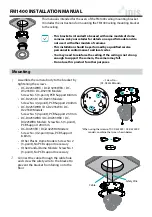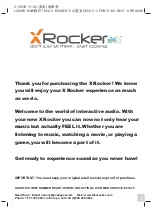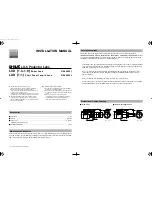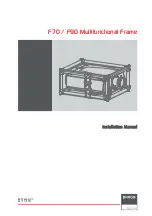
5.
MAINTENANCE, ADJUSTMENTS AND CALIBRATION
Page 193
© 1998-2008 DH Instruments, a Fluke Company
With the piston-cylinder still assembled, thoroughly rinse the assembly in a bath of
water only. Use the same rotating motion as in the previous step.
Remove the piston from the cylinder and thoroughly dry all areas of the assembly using
a lint free towel. DO NOT touch the critical lapped surfaces of the piston or the cylinder
with anything other than the drying towel. Only use one side of the towel during this
process as the other side will become contaminated by contact with the operator’s
hands. Dry thoroughly.
Reassemble the metrological assembly in reverse order.
If the assembly temperature was elevated during cleaning, it may be necessary to wait
to allow the temperature of the assembly to return to ambient temperature before the
assembly will operate normally.
To avoid static build up on the 35 mm ceramic piston surface, do not excessively rub or buff
the surface after it has been dried. After cleaning ceramic elements, it is recommended that they
be discharged to remove any possibility of static charge. This can be accomplished by running a
clean, grounded wire (typically from an ESD pad) across the inner and outer surfaces of the
piston and cylinder.
Quick Method
Of the two cleaning methods, the quick method is less demanding but it is less thorough.
DO NOT undertake piston-cylinder module disassembly without familiarizing yourself with
Section 5.3.1 of this manual. Incorrect disassembly may damage or destroy the piston-cylinder.
Disassemble the piston-cylinder module following the instructions given in Section 5.3.2.1
for PC-7100/7600 modules, Section or Section 5.3.2.2 for PC-7200 modules or Section
5.3.2.3 for PC-7300 modules. Note, it is frequently adequate to clean only the piston of PC-
7200 and PC-7300 modules which avoids complete disassembly of the module.
If you have not already done so, reinstall the cap on the piston.
Apply a small amount of Dow Corning® OS-20 or glass cleaner to a lint free wipe. If
glass cleaner is used, slightly dilute the cleaner using distilled or de-ionized water to help
ensure that no residue will be left behind. Wipe the lapped surfaces (polished
appearance) of both the piston and cylinder.
Using a separate, clean, lint free wipe, wipe the surfaces again to remove any remaining
moisture. If canned air is available, blow the surfaces off with a
slow
flow of air.
Reassemble the piston-cylinder assembly in reverse order.
To avoid static build up on the 35 mm ceramic piston surface, do not excessively rub or buff the
surface after it has been dried. After cleaning ceramic piston, it is recommended that it be discharged
to remove any possibility of static charge. This can be accomplished by running a clean, grounded wire
(typically from an ESD pad) across the inner and outer surfaces of the piston and cylinder.
Содержание PG7000
Страница 10: ...PG7000 OPERATION AND MAINTENANCE MANUAL 1998 2008 DH Instruments a Fluke Company Page VIII N NO OT TE ES S ...
Страница 44: ...PG7000 OPERATION AND MAINTENANCE MANUAL 1998 2008 DH Instruments a Fluke Company Page 34 N NO OT TE ES S ...
Страница 182: ...PG7000 OPERATION AND MAINTENANCE MANUAL 1998 2008 DH Instruments a Fluke Company Page 172 N NO OT TE ES S ...
Страница 210: ...PG7000 OPERATION AND MAINTENANCE MANUAL 1998 2008 DH Instruments a Fluke Company Page 200 N NO OT TE ES S ...
Страница 214: ...PG7000 OPERATION AND MAINTENANCE MANUAL 1998 2008 DH Instruments a Fluke Company Page 204 N NO OT TE ES S ...
Страница 224: ...PG7000 OPERATION AND MAINTENANCE MANUAL 1998 2008 DH Instruments a Fluke Company Page 214 N NO OT TE ES S ...
















































